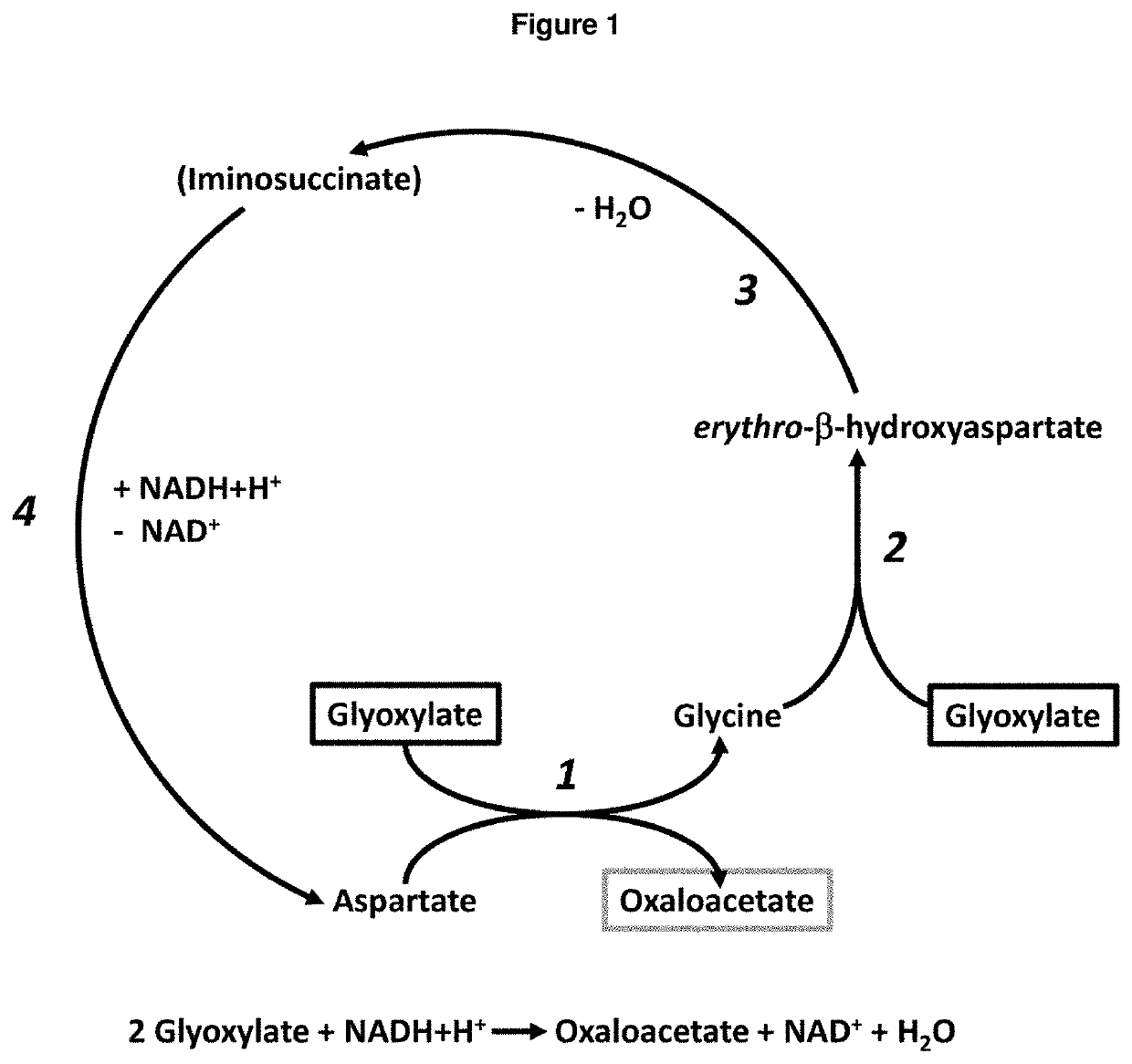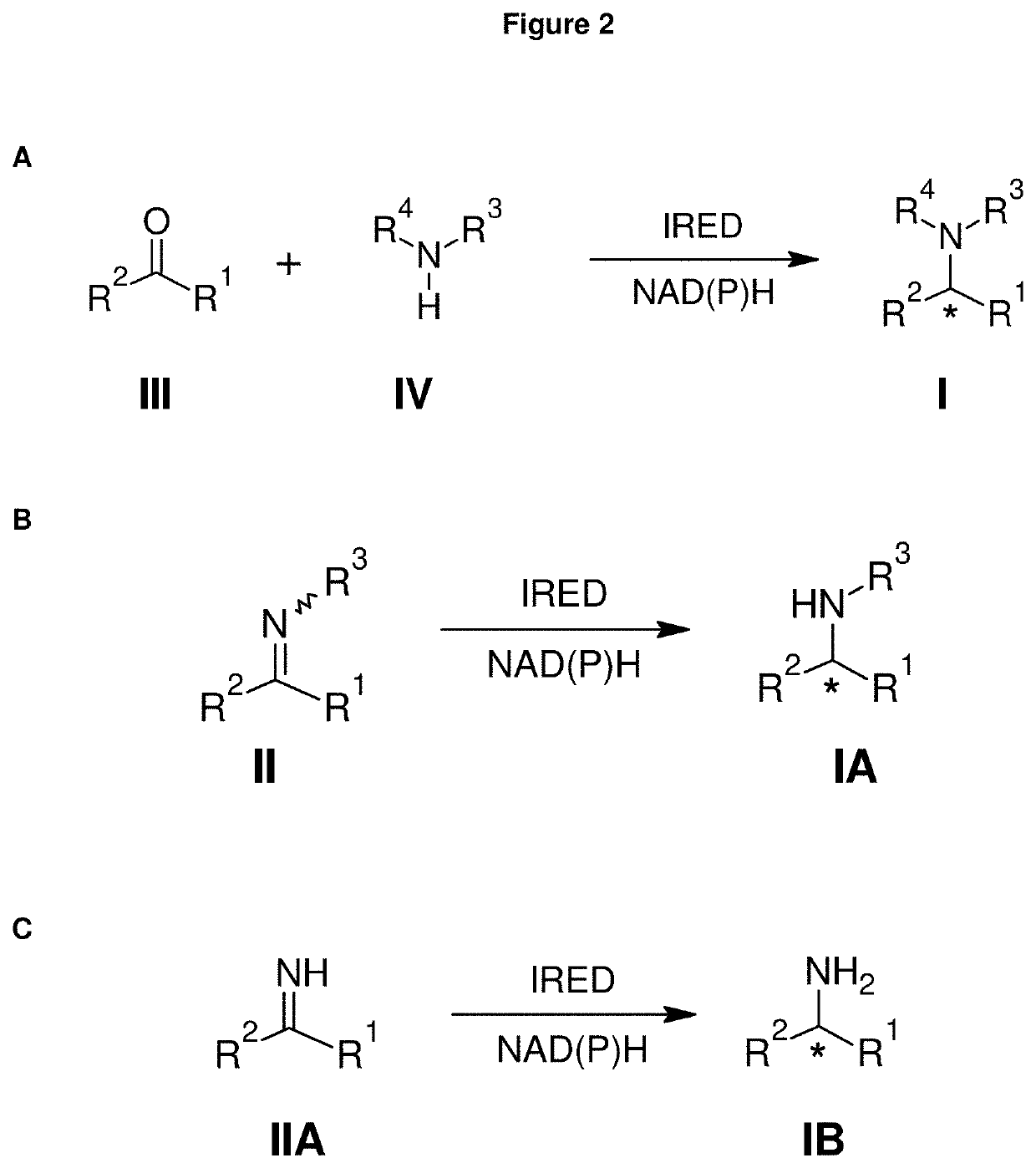Method for preparation of primary amine compounds
a technology of primary amine and amine, applied in the field of primary amine compound preparation, can solve the problems of insufficient cofactor regeneration system for nadph in whole cells, only successful synthesis of secondary and tertiary amines by known imine reductases,
- Summary
- Abstract
- Description
- Claims
- Application Information
AI Technical Summary
Benefits of technology
Problems solved by technology
Method used
Image
Examples
example 1
Construction of Expression Vectors for Heterologous Expression of the Imine Reductase, β-Hydroxyaspartate Aldolase and β-Hydroxyaspartate Dehydratase Polypeptide
[0457]The gene encoding for the imine reductase enzyme from Paracoccus denitrificans DSM 413 (IRed; nucleic acid sequence shown in SEQ ID NO: 135; amino acid sequence shown in SEQ ID NO: 434) was cloned into the standard expression vector pET16b (commercially available from Merck Millipore). To this end, the Red gene was amplified from genomic DNA of Paracoccus denitrificans DSM 413 with the primers
(SEQ ID NO: 603)5′-GACGCCTCATATGCTCGTCGTCGCCGAAAAG-3′(SEQ ID NO: 604)5′-GCCACTCCTCGAGTCAGATCTCGACCTCTTG-3′
[0458]The resulting PCR product was digested with the endonucleases NdeI and XhoI and ligated into the expression vector pET16b to create a vector for heterologous expression of Red.
[0459]The gene encoding for the β-hydroxyaspartate aldolase enzyme from Paracoccus denitrificans DSM 413 (BHAA; nucleic acid sequence shown in SE...
example 2
Heterologous Expression and Purification of Recombinant Proteins
[0463]For the heterologous overexpression of the Red, BHAA and BHAD enzymes, respectively, the corresponding plasmid encoding the respective enzyme was first transformed into chemically competent E. coli BL21 AI cells. The cells transformed with the respective plasmid encoding one of said enzymes were then grown on LB agar plates containing 100 μg mL−1 ampicillin at 37° C. overnight. A starter culture in selective LB medium was then inoculated from a single colony on the next day and left to grow overnight at 37° C. in a shaking incubator. The starter culture was then used on the next day to inoculate an expression culture in selective TB medium in a 1:100 dilution. The expression culture was grown at 37° C. in a shaking incubator to an OD600 of 0.5 to 0.7, induced with 0.5 mM IPTG and 0.2% L-arabinose and grown overnight at 18° C. in a shaking incubator.
[0464]Cells were harvested at 6,000×g for 15 min and cell pellets ...
example 3
Enzyme Assays
[0465]The enzyme assay to generate iminosuccinate from glyoxylate and glycine (catalyzed by the BHAA and BHAD enzymes) and further chemical reduction of iminosuccinate to aspartate with the reducing agent NaCNBH3 was performed at 30° C. in a total volume of 600 μl. The reaction mixture contained 50 mM Tris pH 7.5, 1 mM glycine, 1 mM glyoxylate, 0.1 mM PLP, 1 mM MgCl2, 60 μg BHAA enzyme, 5.4 μg BHAD enzyme and varying amounts of NaCNBH3 (0, 1 or 5 mM, respectively). The reaction was carried out in deuterated water (D2O). 180 μL aliquots were taken at time points 0, 1 and 3 minute(s) and the reaction was immediately stopped by addition of formic acid (4% final concentration). The samples were centrifuged at 17,000×g and 4° C. for 15 min and the supernatant diluted 1:4 in double-distilled water for LC-MS analysis (see FIG. 3).
[0466]The enzyme assay to generate aspartate from glyoxylate and glycine (catalyzed by the BHAA, BHAD and ISRed enzymes) was performed at 30° C. in a...
PUM
| Property | Measurement | Unit |
|---|---|---|
| concentration | aaaaa | aaaaa |
| concentration | aaaaa | aaaaa |
| concentration | aaaaa | aaaaa |
Abstract
Description
Claims
Application Information
 Login to View More
Login to View More - R&D
- Intellectual Property
- Life Sciences
- Materials
- Tech Scout
- Unparalleled Data Quality
- Higher Quality Content
- 60% Fewer Hallucinations
Browse by: Latest US Patents, China's latest patents, Technical Efficacy Thesaurus, Application Domain, Technology Topic, Popular Technical Reports.
© 2025 PatSnap. All rights reserved.Legal|Privacy policy|Modern Slavery Act Transparency Statement|Sitemap|About US| Contact US: help@patsnap.com



